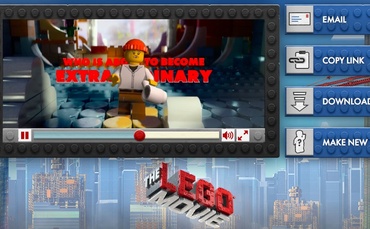For three weeks now, The Lego Movie has dominated the U.S. box office, as children and adults alike flock to explore an animated world of interlocking plastic bricks. The movie has its share of stars, Liam Neeson, Elizabeth Banks, and Morgan Freeman among them, but this isn’t what makes its success significant. The Lego Movie is branded content – possibly the “biggest, most high-profile” branded content ever made, but branded content all the same.
To be clear, the film wasn’t produced by Lego. The company was reportedly “cautious” about the idea of a Lego movie from the start. But filmmaker Dan Lin, who’s associated with Warner Bros., wanted to make a movie his young sons could watch, and so he pitched Denmark’s The Lego Group and the project developed from there. Now, there’s a sequel on the way.
Even though the effort wasn’t initiated by the brand, Lego’s decision to support it was risky. Already established and well-loved by consumers around the world, Lego had more to lose than to gain. How, then, did all parties involved assemble a project that doesn’t feel commercial? With a clever strategy, executed brick by brick.
The Importance of Being Interactive
Those who’ve seen the film know creativity and imagination are paramount to its storyline, but it’s worth noting that these themes were introduced to the public early on. Two years prior to The Lego Movie‘s release, The Lego Group and Warner Bros. launched a contest asking fans to create a custom vehicle for inclusion in the film. Open to children and young adults in three age categories, the contest was promoted on Lego’s Facebook page as well as with a video on YouTube. Fans had four months within which to submit a photo of their creation via The Lego Movie‘s site.
The Web-based competition served to pique the interest of Lego fans and generate preliminary buzz, but it also gave consumers a reason to follow news of the movie during the many months leading up to the premiere. Inviting potential viewers to engage with the project gained Lego and Warner Bros. a coterie of fans. And they didn’t even need a movie clip to do it.
Later, the companies built on this foundation of interactivity by introducing a Web-based “SigFig” creator on The Lego Movie site. Fans can use it to virtually construct a Lego figurine in their likeness, and watch it star in a customized trailer. Together, the contest and app produce an immersive content experience that extends well beyond the screen.

Valuing Integration
What makes a brand successful? Well-liked? Financially sound? In part it’s integration: linking products with packaging and promotion across multiple platforms such that users get a cohesive brand experience wherever they go. This marketing strategy as it relates to Lego was eloquently described in a recent post on CNN Money: Lego, writer Geoff Colvin said, is “a machine that creates an extended customer experience with its brand, in multiple media and physical spaces.”
For that “machine,” The Lego Movie represents the common thread that effectively ties together every offshoot. With a message in keeping with the tenets of the brand, a fully immersive Lego world, and a cast of characters born of the existing licensing deals with third-party companies that have stacked toy store shelves, this one piece of branded content fully unites the brand. Product lines and packaging suddenly appear interrelated, and gain new meaning in the context of pure amusement.
Story Comes First
Above all else, The Lego Movie is a hit because it wasn’t treated as branded content. The product and brand are so interwoven with the film that it couldn’t exist without them, and yet nothing about the experience reads “ad.” The Lego Movie delivers a hero quest story that viewers can relate to, along with humor and a fast-moving plot. Any nods to the product or time-honored role that Lego toys play in our lives (such as Benny, the “1980-something spaceman” of 21st-century parents’ youth) aren’t perceived as promotion, because they’re so well integrated into the plot.
The Lego Movie may be built around a brand, but it’s the story that’s made to matter. The content doesn’t appear overtly persuasive because it isn’t: what’s being sold is good storytelling using a unique medium that happens to be available in stores. In essence, Lego is simply underwriting a project that takes the form of quality entertainment. This ensures the company won’t be demurred, but instead accepted for its part in facilitating a desirable consumer experience.
And that’s something a brand can build on.







